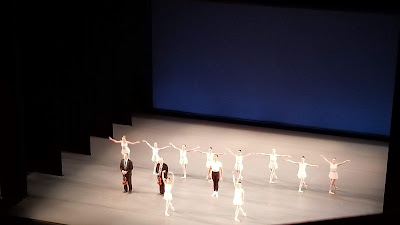SAB Workshop Ushers in New Stars while NYCB Ends Season
 |
| View from the 4th Ring for Concerto Barocco |
Sunday June 3 was a bittersweet event for NYCB fans as three senior members of the company gave Long-time soloist Savannah Lowery and senior corps members Cameron Dieck and Likolani Brown all retired today. It's a happy occasion: all three dancers are headed towards
second careers but for dance audiences when senior members of the company leave it's always a loss.
Lowery as a farewell present was given two assignments -- the second violin to Ashley Laracey's first violin in Concerto Barocco, and the Agon pas de trois. I will miss Brown, who often led the Flowers in Nutcracker. You could always pick her out of a crowd with her dark hair and sweet face. I will also miss Dieck, who was one of my favorite Bottoms. Dieck's final turn onstage was as Theme 3 in Four Temperaments. He was dancing with his off-stage girlfriend Unity Phelan and the orchestra actually slowed down the tempo considerably, probably to allow Dieck to savor his last moments as a dancer. The crowd cheered loudly for Lowery during curtain calls. I wish she had been allowed a solo bow but oh well. |
| Farley and Laracey, photo @ Erin Baiano |
 |
| Western Symphony Cast in SAB Workshop |
Last night's workshop had a couple dancer standouts. The entire Western Symphony cast was filled with tall, leggy female stunners and short male dynamos. The smaller auditorium allowed audiences to see little nuances in the choreography that get lost in the larger D*v*d K*ch Theatre. For instance I've been watching this ballet over many years and never noticed the comical waving between the male and female in the adagio. Mary Kate Edwards in the Allegro impressed with her cool, regal presence -- already she reminded me of Tess Reichlen. Maybe the most charming pairing was the Adagio's Mia Domini with the pocket-sized Victor Rosario. In the Rondo Cainan Weber wowed the crowd with his huge cowboy leaps while Juliane Kinawsiewitz was that high-kicking high energy girl that Western Symphony needs but often doesn't get.
 |
| In Creases cast with Craig Hall |
 |
| Anderson, Weber, Hong |
 |
| Bouder and Gordon and the rest of the Coppelia cast |
Senior ballerina Ashley Bouder was making her debut as Swanilda after 18 (!!!) years in the company. On the surface she doesn't seem like a natural Swanilda -- she's always been a technical wonder but often short on charm. And indeed she was a very different Swanilda than the sweet, cute Sterling Hyltin from last week -- Bouder's Swanilda had sharper edges, fiercer attack, and a broader interpretation. And yet the portrayal worked. Bouder did some of the most appealing dancing I've seen from her in ... a long time. What was it? Patricia McBride's coaching? Her explosive pas de chats are always astonishing, as are her long-held balances. But for once Bouder didn't let her technique overpower her characterization. Her doll imitation in Act 2 was very funny and delightfully mean -- at one point the audience gasped as she "accidentally" slapped poor Dr. Coppelius in one of her doll arm movements.
 |
| Bouder and Gordon |
 |
| Adams, Boisson, Sell, Jones |
So that's a wrap for NYCB's 2017-18 season that weathered the huge crisis of Peter Martins' sudden dismissal, the leave of Amar Ramasar, Justin Peck and Brittany Pollack to go do Broadway, the usual share of injuries (most distressing: Adrian Danchig-Waring), and the pressure of reviving all those ballets for the Robbins Festival.
And now, in no particular order, some random highs from the season:
Best Farewell: Robert Fairchild's last dance in Duo Concertant with his frequent partner Sterling Hyltin. Heart-melting. Sublime. Unforgettable.
Most Revelatory Interpretation: Adrian Danchig-Waring's raw, powerful, very un-pretty Apollo. Over the years this ballet has lost its demi-character roots as Peter Martins' stamp became more and more engrained into the ballet's DNA. Danchig-Waring brought it back.
Best Robbins' Revival: In G Major. I don;t know why this isn't revived more often but it's an absolutely beautiful ballet that brought out the best in Maria Kowroski, who can struggle in Balanchine ballets.
Best Rising Stars: The phenomenal Roman Mejia and the appealing energetic Harrison Coll, both of whom are still in the corps but dancing more and more soloist roles.
Best Improvement from the Martins Era: NYCB alumni being invited back to coach. Mikhail Baryshnikov came back to coach Suite of Dances and Other Dances. Patricia McBride came back to coach Baiser de la Fee and Coppélia. Jacque d'Amboise coached Apollo. Who's next?

Comments
Post a Comment